How to Write a Letter Asking for Donations

Donation letters are some of the most effective ways to reach your donors and solicit a gift. However, it's not enough to simply send the same appeal to your entire supporter base and ask them to make a donation.
Writing a great donation letter is an opportunity to engage supporters and show them the impact they have on your mission. By putting thought behind your donation letter content, your nonprofit will not only increase your fundraising revenue but also develop relationships with those supporters.
Whether you're just starting your donation letter strategy or seeking ways to improve it, it's always a good idea to review the basics and make sure your communication strategies lay a solid foundation for growth.
Follow along with us from the top or skip through the navigation to the topic that interests you most:
- Donation Letters: The Basics
- How to Write the Perfect Donation Request Letter
- How to End a Donation Request Letter
- Best Practices When Writing Donation Letters
- Donation Letter Templates
Ready to start crafting the perfect donation letter to send to supporters? Let's begin!

Donation Letters: The Basics
To review the basics of donation letters and how your nonprofit can best leverage them, we'll be answering the following common questions:
1. What is the purpose of donation letters?
Donation letters are a fundraising tool that many nonprofit professionals use to reach prospective donors and entice them to donate. They can be especially effective for mass giving days and other dedicated campaigns. Donation letters can either be sent via direct mail or email, depending on the recipient's preference.
Donation letters are most frequently sent when a nonprofit is asking for financial support, but they can also be used to ask for in-kind donations!
2. How often should you send donation letters?
Many fundraising professionals would recommend around four direct mail donation letters per year, with one email per month. However, this number will vary depending on both the donor and the nonprofit.
A good idea is to send out a survey asking for communication preferences as soon as someone makes a donation or opts into any of your email lists. Then, record that data within your fundraising platform and refer to it when you schedule future correspondences.
3. To whom do you send donation letters?
As you're first building out the recipient list for your donation letters, your best bet is to look at previous donors. They're already familiar with your organization and your work, meaning they're more likely to give again.
Donation letters are also a great way to engage supporters who have never given before. For instance, you can take a look at your database of past volunteers. Even though you know they've never given, you also know that they support your mission.
4. How should you send your donation letters?
You can send donation letters by direct mail or email, with most fundraisers probably taking advantage of both channels. However, each recipient likely has their own preferences.
For instance, let's say you have a very loyal supporter who travels for work, so they're often not home. Sending them any direct mail might not be worth the effort, and you should increase your email communications instead. To best determine how often you should send donation letters to each of your donors, ask them! Try sending donors a survey to learn more about their communication preferences.

How To Write the Perfect Donation Request Letter
To write the perfect donation request letter, follow these simple steps:
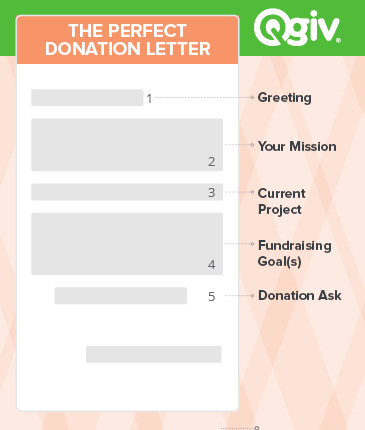
- Start with a greeting.
Make sure you open up your letter by greeting the recipient. It's important that you include their name– donation letters without a name seem impersonal and are more likely to be ignored. When donors read direct mail appeals, the first thing they look for is a personalized salutation. Some studies show that emails including names in the salutation are 26% more likely to be opened! Whether you're writing the letter by hand or through a communications tool, don't forget this vital detail.
- Explain your mission.
If the recipient hasn't heard of your organization before, you definitely need to explain your mission at the beginning. This way, readers get a good understanding of what you're fighting for and the goals you want to accomplish. One of the best ways to do this is by sharing a story from someone who's benefited from your organization, and then sharing how donors helped make a difference in that person's life. This connects donors to your mission and shows them the people they'll help with a gift.
- Describe the current project/campaign/event.
You're likely sending out a donation letter for a specific reason, whether that's a project, campaign, or event. Make sure to describe that reason clearly and include key details like dates or guidelines. The story at the beginning of your donation letter will reinforce your appeal!
- Include why this project is in need and what you hope to accomplish.
Don't forget to explain why it's important for your donors to support this project. How does it help them make a difference? Why should they give to this program in particular? For instance, if you're raising money to provide resources to schools around the world, tell your donors the exact school and community their donations will support. Giving a backstory is a great way to connect deeper with prospective donors.
- Make your donation ask with a specific amount correlated with that amount's impact.
Donors like knowing exactly where their money is going and how it will help make a difference. Within your donation request letter, make a strong donation ask by describing specifically what that gift will do. For example, stating that a donation of $100 provides a dog with food, shelter, and medicine helps donors understand their impact. It may also inspire more generosity—they might decide to increase their original $50 donation to $100!

How to End a Donation Request Letter
As you wrap up your donation request letter, there are two essential things to consider:
- Include a clear and direct call to action so readers know how they can give. Ideally, your donation letter has inspired donors to make a difference by sending in a gift. Tell them exactly what you want them to do, and then make it easy to act!
- End the letter by signing your name, including any contact information, and thanking your audience for their future gift. Anyone who makes a gift to your organization deserves to be thanked sincerely. Even if your donation letter is simply asking for a gift, thanking the recipient for their time and attention shows that you appreciate them taking the time to read your appeal.

Best Practices When Writing Donation Letters
Donation letters and other donor communications are a great way to build those important relationships and, in turn, increase your donor retention rates . To be most effective, though, your communications must be personable and relevant to the recipient.
To best connect with your donation letter recipients, here are some best practices you can follow:
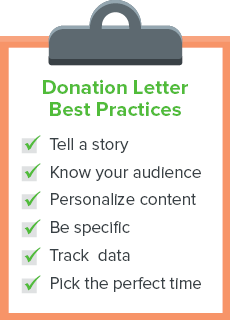
- Tell a story. It's been proven that a captivating story is one of the best ways to connect with your donors. In your donation letter, make sure to include a personal story from someone that's benefited from your programming. Instead of telling a donor what your organization does, show them! This is a great way to introduce your mission to those who haven't heard about your organization before in a compelling way.
- Know your audience. You're going to be sending donation letters to a wide variety of supporters, whether they're young or old, past donors or new donors, one-time or recurring donors. Your donation letter should reflect those differences by catering to those various donor segments. For instance, a donation letter to someone who previously gave before should include an acknowledgment of that fact as well as the impact of that gift.
- Personalization is key. As mentioned earlier, simply including the recipient's name in your donation appeals can increase conversion rates. Ensure that your communication tools and donor database are integrated so you can automate this process and easily personalize each donation letter you send out.
- Be specific. When asking for donations from supporters, you have to be specific about what you want them to do. Don't just specify why your organization needs funds during this time— specify how much you want them to give by suggesting exact donation amounts. It's also helpful to explain why donors should give now instead of waiting to make a gift. When your recipients understand the appeal's urgency and have an idea of how much they should give, they're more likely to donate immediately instead of waiting.
- Track donation letter data. Each time you send a donation letter, whether it's by email or direct mail, you should be collecting and storing data about that letter's performance. Make sure your tools can track important data points like the recipient's name, whether the recipient responded, and how often donation letters convert to gifts.
- Pick the perfect time to send it. Try to send a direct mail donation letter at the beginning of your campaign. You don't want to risk asking too late—the recipient may not have enough time to make a gift before your campaign ends! On the other hand, sending one too early can have its drawbacks, too. For example, if you're sending a donation letter asking for gifts to your Giving Tuesday campaign, sending too early may result in the recipient forgetting about the event before it even happens. Carefully consider the perfect time to send donation letters and find that sweet spot between too late and early.
Your donation letter has one primary purpose: to inspire donors to give. But a great donation appeal letter does more! By following these donation letter best practices, you lay the foundation for future engagement. Sending an engaging, inspiring donation letter gives you the opportunity to get to know your supporters better and build long lasting relationships.

Donation Letter Templates
To get you started on your donation request letter journey, we've provided templates below for common situations:
General Donation Request Letter
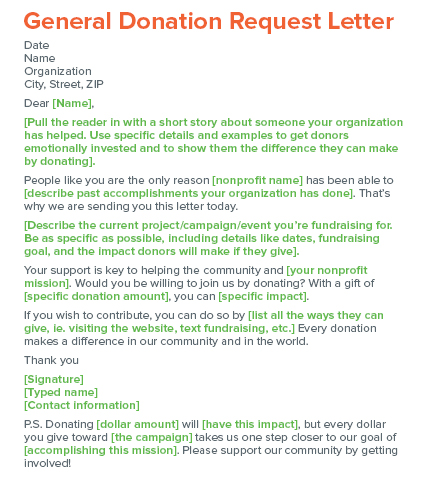
When sending a donation request letter, there's a standard format you can follow or adjust to suit your unique voice and audience. Above all, your donation request letter should be personalized to the recipient and effectively explain how their donation will make a difference in the world.
This template is very generic and can be referenced for any type of fundraising effort. Use the template for guidance to ensure you hit the most important points, but feel free to add your own spin to it in order to better connect with your audience.
Thank You Donation Letter Template
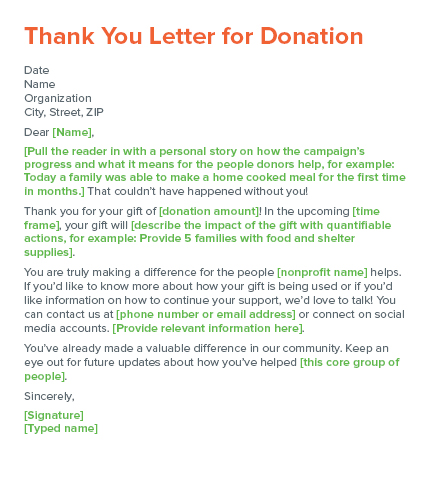
Every donation you receive should be answered with a heartfelt thank-you letter. After all, without the support from your donors, your organization wouldn't be able to make the meaningful difference it has.
When crafting your thank-you donation letter, feel free to use this template to guide you. This way you know you're keeping the content personal and effectively showing appreciation to the donor. Remember to include the impact of the gift so that donors know it was put to good use.
Donation Letter Template During a Crisis
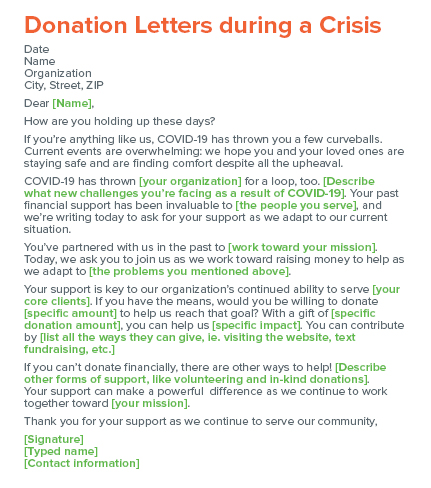
Writing a donation letter during times of crisis and instability may seem like a daunting task. When approaching delicate topics like this, your best bet is to acknowledge it right off the bat and let donors know you understand their situation. In the end, it's important to remember that these letters should be donor-centric and focus on connecting the donor to the people they'll help.
Follow our template here for more tips on the important points and details to hit. As always, you can add additional information that's pertinent to your organization.
Feel free to use any of these donation letter templates to help you with your communication and fundraising needs. Having the resources to effectively reach your donors is the best way to develop relationships and increase fundraising for your organization.
We've written about fundraising letters before, and have even more templates for different situations. If you're curious about how to specifically write a school fundraising letter or a matching gift fundraising letter, we urge you to check out our other fundraising letter guide with templates.

How to Write a Letter Asking for Donations
Source: https://www.qgiv.com/blog/donation-request-letters/